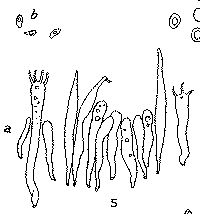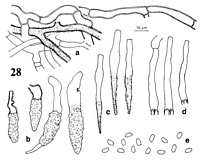|
 Phanerochaete luteoaurantiaca Phanerochaete luteoaurantiaca
SynonymsCorticium luteoaurantiacum
BiostatusPresent in region - Indigenous. Endemic
Images (click to enlarge)
Caption: PLATE II. Fig. 5. Corticium luteo-aurantiacum n. sp. All figures x about 650.
a. Section of hymenium, showing basidia and cystidioles. b. Spores. | 
Caption: FIG. 28. Phanerochaete luteo-aurantiaca (holotype), a. subicular hyphae, b. heavily
encrusted cystidia, c. lightly encrusted cystidia, d. basidia, and e. basidiospores. |
Article: Burdsall, H.H. (1985). A contribution to the taxonomy of the genus Phanerochaete (Corticiaceae, Aphyllophorales). Mycologia Memoirs 10: 165 p.
Description: Basidiocarps adherent, broadly effused, membranous to ceraceous, smooth, up to 1 mm
thick; fertile area "greyish orange" (near 5B4), not changing color in KOH; margin
abrupt, not differentiated; subiculum pale yellow, very thin, often not observable. Hyphal
system monomitic. Subiculum sparse, not evident in many sections, hyphae 4-6.5 µm
diam, thin walled to firm walled, yellow, with regular branching at right angles, smooth
or coated with orange granules that frequently dissolve in KOH turning solution yellow,
simple septate; subhymenium making up most of thickness, with hymenial elements
imbedded at all levels, hyphae 3-4.5 µm diam, hyaline, thin walled; cystidia of two
kinds, some subulate and mostly smooth or only lightly covered with orange granules,
with most granules dissolving in KOH; some heavily encrusted and cylindrical, 35-65 x
4-6 µm (-9 µm when heavily encrusted), thin walled or with only slight thickening, with
rare secondary septa, embedded at all levels, the embedded ones with orange crystals,
persistent even in KOH; basidia cylindrical, 40-50 x 5-6 µm, thin walled, hyaline,
4-sterigmate, sterigmata up to 3.5 Itm long; basidiospores ellipsoid to narrowly ellipsoid,
5-5.5 x 2.5-3 µm, hyaline, smooth, thin walled, Melzer's -, acyanophilous.
Habitat: On bark of dead branches.
Distribution: New Zealand, known only from type collection.
Notes: Discussion: The only Phanerochaete species with which P. luteo-aurantiaca could be
confused is P. ericina. Phanerochaete luteo-aurantiaca is distinguished by cystidia
encrusted with orange crystals or granules and by the absence of the much branched
binding-type hyphae present in P. ericina.
Article: Wakefield, E.M. (1915). On a collection of fungi from Australia and New Zealand. Kew Bulletin of Miscellaneous Information 1915(8): 361-376.
Notes: A beautiful and conspicuous species with its bright yellow colour varying to tawny orange. In
the possession of slender crystidioles [sic], it is allied to C. ochraceo-favum Bourd. & Galz.;
but it differs in the more brilliant colouring and softer (less horny) consistency when dry. The
colouring matter is soluble in alkalies, forming a bright yellow solution.
|